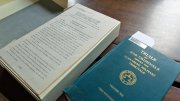On Thursday, the Harvard Law School Library released a digital archive of its records from all 13 Nuremberg trials, a massive trove of documents chronicling the effort after World War II to bring Nazi leaders to justice. The first complete set of Nuremberg records to be made publicly available online, the archive is fully searchable. Its release comes on the 80th anniversary of the first trial, an international military tribunal convened on November 20, 1945 that prosecuted 22 of the surviving top leaders from Nazi Germany. During the subsequent four years, a total of 199 Nazi officials were tried, and 12 were given death sentences. Just three were found not guilty. Numerous Harvard alumni were involved in the proceedings, including prosecutors Telford Taylor, LL.B. ’32, and Benjamin Ferencz, LL.B. ’43, and tribunal judge Francis Biddle, LL.B. ’11.
The library’s digitization project got underway in 1998 and was initially conceived as a way to preserve the fragile documents, which fill some 730 boxes, while also making them widely available. One of several major institutions in the United States and Europe to possess copies of the trial documents, Harvard received the bulk of its archive in 1949, after the last trial ended. In the decades since, other related records have been donated and added to the archive. “For the most part, these are 1940s-era acid-based mimeograph sheets of paper,” says Paul Deschner, who led the digitization project. “And basically, all that stuff is crumbling as we speak.” The deterioration became such a problem that in the early 2000s, the library had to take the physical archive out of circulation.
The database now houses some 140,000 documents—more than 750,000 individual pages. This includes records from the trials themselves: transcripts, briefs, and evidence exhibits for both the prosecution and defense. There is also a vast pool of what Deschner calls “source documents,” which were never used at trial but were dug up by investigators at the time and selected as relevant to the effort to understand the Nazi regime. Altogether, it’s an astonishing breadth of material, “almost everything imaginable,” Deschner says: letters, memos, meeting minutes, diaries, telegrams, newspaper clippings, journal excerpts, maps, photographs, and organization charts of the Nazi hierarchy. There are records from a 1942 meeting in Berlin where the Holocaust was introduced as an official policy. A 1945 photograph shows the Nuremberg cell block where the Nazi defendants were being held, with a soldier standing guard outside each cell door.
Organizing these records has been the work of decades. Since 2003, the library has shared some of the documents online, including from the international military tribunal (“the one everyone thinks of when they talk about the Nuremberg trials,” Deschner says) and the subsequent trial of Nazi doctors. Library officials finished scanning the entire archive in 2017, a process that involved carefully disassembling documents that were stapled or tied together and removing covers and bindings from bound volumes. After that, Deschner says, “it became a metadata project”—a huge, labor-intensive undertaking that involved analyzing and categorizing each individual document to make it usable for researchers. About 30 percent of the archive, primarily the trials’ evidentiary records, have what Deschner calls the “richest metadata,” which means detailed tagging across a number of information fields and in-depth descriptive summaries. The rest of the archive includes more basic tagging and descriptions, but enough, he says, “to let people connect with the document.” The team did not use AI for this work, but Deschner hopes that as the technology improves, it will be useful in converting the scanned images of records into searchable text files.
Also, although the database includes every English-language document, most of the German-language records—about 30 percent of the library’s Nuremberg holdings—have not yet been digitized. “But we have the parallel English translations for everything online,” Deschner says. “So, content-wise, the database is close to 100 percent of the full physical archive.”
Next on the horizon for Deschner and his staff is a project to digitize records from another postwar trial, the International Military Tribunal for the Far East, more commonly known as the Tokyo War Crimes Tribunal, which began in 1946. Modeled after the Nuremberg tribunal, the two-year trial prosecuted leaders in Japan. That archive is much smaller, just 87 boxes of documents. “Right now, we’re starting to scan those,” he says. “We haven’t made the full pivot, but the work has begun.”









